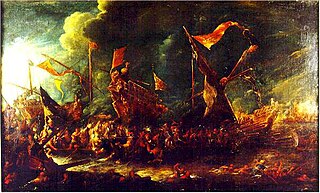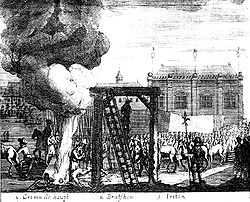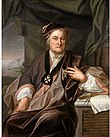
1648 (MDCXLVIII) was a leap year starting on Wednesday of the Gregorian calendar and a leap year starting on Saturday of the Julian calendar, the 1648th year of the Common Era (CE) and Anno Domini (AD) designations, the 648th year of the 2nd millennium, the 48th year of the 17th century, and the 9th year of the 1640s decade. As of the start of 1648, the Gregorian calendar was 10 days ahead of the Julian calendar, which remained in localized use until 1923.

1662 (MDCLXII) was a common year starting on Sunday of the Gregorian calendar and a common year starting on Wednesday of the Julian calendar, the 1662nd year of the Common Era (CE) and Anno Domini (AD) designations, the 662nd year of the 2nd millennium, the 62nd year of the 17th century, and the 3rd year of the 1660s decade. As of the start of 1662, the Gregorian calendar was 10 days ahead of the Julian calendar, which remained in localized use until 1923.
The 1640s decade ran from January 1, 1640, to December 31, 1649.

1644 (MDCXLIV) was a leap year starting on Friday of the Gregorian calendar and a leap year starting on Monday of the Julian calendar, the 1644th year of the Common Era (CE) and Anno Domini (AD) designations, the 644th year of the 2nd millennium, the 44th year of the 17th century, and the 5th year of the 1640s decade. As of the start of 1644, the Gregorian calendar was 10 days ahead of the Julian calendar, which remained in localized use until 1923.

The 1620s decade ran from January 1, 1620, to December 31, 1629.

1650 (MDCL) was a common year starting on Saturday of the Gregorian calendar and a common year starting on Tuesday of the Julian calendar, the 1650th year of the Common Era (CE) and Anno Domini (AD) designations, the 650th year of the 2nd millennium, the 50th year of the 17th century, and the 1st year of the 1650s decade. As of the start of 1650, the Gregorian calendar was 10 days ahead of the Julian calendar, which remained in localized use until 1923.

1685 (MDCLXXXV) was a common year starting on Monday of the Gregorian calendar and a common year starting on Thursday of the Julian calendar, the 1685th year of the Common Era (CE) and Anno Domini (AD) designations, the 685th year of the 2nd millennium, the 85th year of the 17th century, and the 6th year of the 1680s decade. As of the start of 1685, the Gregorian calendar was 10 days ahead of the Julian calendar, which remained in localized use until 1923.

1630 (MDCXXX) was a common year starting on Tuesday of the Gregorian calendar and a common year starting on Friday of the Julian calendar, the 1630th year of the Common Era (CE) and Anno Domini (AD) designations, the 630th year of the 2nd millennium, the 30th year of the 17th century, and the 1st year of the 1630s decade. As of the start of 1630, the Gregorian calendar was 10 days ahead of the Julian calendar, which remained in localized use until 1923.

1613 (MDCXIII) was a common year starting on Tuesday of the Gregorian calendar and a common year starting on Friday of the Julian calendar, the 1613th year of the Common Era (CE) and Anno Domini (AD) designations, the 613th year of the 2nd millennium, the 13th year of the 17th century, and the 4th year of the 1610s decade. As of the start of 1613, the Gregorian calendar was 10 days ahead of the Julian calendar, which remained in localized use until 1923.

1641 (MDCXLI) was a common year starting on Tuesday of the Gregorian calendar and a common year starting on Friday of the Julian calendar, the 1641st year of the Common Era (CE) and Anno Domini (AD) designations, the 641st year of the 2nd millennium, the 41st year of the 17th century, and the 2nd year of the 1640s decade. As of the start of 1641, the Gregorian calendar was 10 days ahead of the Julian calendar, which remained in localized use until 1923.

1643 (MDCXLIII) was a common year starting on Thursday of the Gregorian calendar and a common year starting on Sunday of the Julian calendar, the 1643rd year of the Common Era (CE) and Anno Domini (AD) designations, the 643rd year of the 2nd millennium, the 43rd year of the 17th century, and the 4th year of the 1640s decade. As of the start of 1643, the Gregorian calendar was 10 days ahead of the Julian calendar, which remained in localized use until 1923.

1649 (MDCXLIX) was a common year starting on Friday of the Gregorian calendar and a common year starting on Monday of the Julian calendar, the 1649th year of the Common Era (CE) and Anno Domini (AD) designations, the 649th year of the 2nd millennium, the 49th year of the 17th century, and the 10th and last year of the 1640s decade. As of the start of 1649, the Gregorian calendar was 10 days ahead of the Julian calendar, which remained in localized use until 1923.

1689 (MDCLXXXIX) was a common year starting on Saturday of the Gregorian calendar and a common year starting on Tuesday of the Julian calendar, the 1689th year of the Common Era (CE) and Anno Domini (AD) designations, the 689th year of the 2nd millennium, the 89th year of the 17th century, and the 10th and last year of the 1680s decade. As of the start of 1689, the Gregorian calendar was 10 days ahead of the Julian calendar, which remained in localized use until 1923.
The 1660s decade ran from 1 January 1660, to 31 December 1669.

The 1650s decade ran from January 1, 1650, to December 31, 1659.

1654 (MDCLIV) was a common year starting on Thursday of the Gregorian calendar and a common year starting on Sunday of the Julian calendar, the 1654th year of the Common Era (CE) and Anno Domini (AD) designations, the 654th year of the 2nd millennium, the 54th year of the 17th century, and the 5th year of the 1650s decade. As of the start of 1654, the Gregorian calendar was 10 days ahead of the Julian calendar, which remained in localized use until 1923.

1581 (MDLXXXI) was a common year starting on Sunday in the Julian calendar, and a common year starting on Thursday in the Proleptic Gregorian calendar.

1656 (MDCLVI) was a leap year starting on Saturday of the Gregorian calendar and a leap year starting on Tuesday of the Julian calendar, the 1656th year of the Common Era (CE) and Anno Domini (AD) designations, the 656th year of the 2nd millennium, the 56th year of the 17th century, and the 7th year of the 1650s decade. As of the start of 1656, the Gregorian calendar was 10 days ahead of the Julian calendar, which remained in localized use until 1923.

1663 (MDCLXIII) was a common year starting on Monday of the Gregorian calendar and a common year starting on Thursday of the Julian calendar, the 1663rd year of the Common Era (CE) and Anno Domini (AD) designations, the 663rd year of the 2nd millennium, the 63rd year of the 17th century, and the 4th year of the 1660s decade. As of the start of 1663, the Gregorian calendar was 10 days ahead of the Julian calendar, which remained in localized use until 1923.

1664 (MDCLXIV) was a leap year starting on Tuesday of the Gregorian calendar and a leap year starting on Friday of the Julian calendar, the 1664th year of the Common Era (CE) and Anno Domini (AD) designations, the 664th year of the 2nd millennium, the 64th year of the 17th century, and the 5th year of the 1660s decade. As of the start of 1664, the Gregorian calendar was 10 days ahead of the Julian calendar, which remained in localized use until 1923.
























